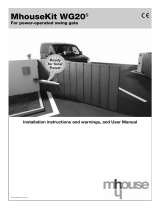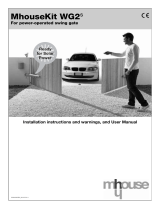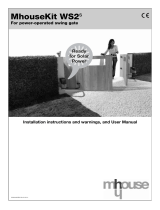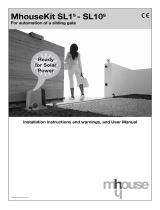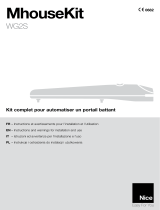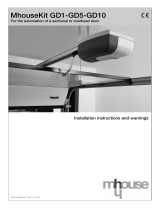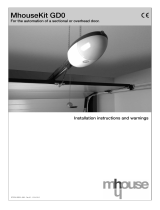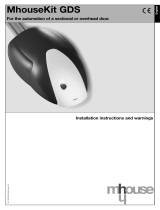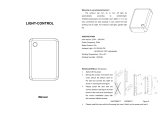Page is loading ...

MhouseKit WU2
S
For power-operated swing gate
Installation instructions and warnings, and User Manual
IS0005A00EN_28-02-2011


English – 1
English
SAFETY WARNINGS AND GENERAL PRECAUTIONS
STEP 1 2
KNOWLEDGE OF THE PRODUCT AND PREPARATION FOR
INSTALLATION
STEP 2 2
2.1 - PRODUCT DESCRIPTION AND INTENDED USE 2
2.2 - COMPONENTS USED TO SET UP A COMPLETE SYSTEM 3
PRELIMINARY CHECKS FOR INSTALLATION
STEP 3 3
3.1 - CHECKING SUITABILITY OF GATE TO BE AUTOMATED
AND RELATIVE ENVIRONMENT 3
3.2 - PRODUCT APPLICATION LIMITS 3
3.3 - PRODUCT DURABILITY 3
STEP 4 4
4.1 - PRELIMINARY CHECKS FOR INSTALLATION 4
4.2 - PREPARING ELECTRIC CABLES 4
INSTALLATION: ASSEMBLY AND CONNECTION OF
COMPONENTS
STEP 5 6
5.1 - INSTALLING THE GEARMOTOR WU1SK 6
STEP 6 7
6.1 - INSTALLING CL2S 7
6.2 - INSTALLING AND CONNECTING PHOTOCELLS PH100 7
6.3 - INSTALLING AND CONNECTING THE FLASHING LIGHT FL100 7
6.4 - ELECTRICAL CONNECTION TO CONTROL UNIT CL2S 7
PROGRAMMING
STEP 7 13
7.1 - POWER SUPPLY CONNECTION 13
7.2 - INITIAL CHECKS 13
7.3 - LEARNING CONNECTED DEVICES 13
7.4 - LEARNING THE GATE LEAF OPENING AND CLOSING ANGLES 13
7.5 - CHECKING THE RADIO TRANSMITTERS 13
7.6 - SETTINGS 13
TESTING AND COMMISSIONING
STEP 8 15
8.1 - TESTING 15
8.2 - COMMISSIONING 15
MAINTENANCE
STEP 9 15
PRODUCT DISPOSAL 15
FURTHER INFORMATION
STEP 10 16
10.1 - ADVANCED SETTINGS 16
10.2 - OPTIONAL ACCESSORIES 17
10.3 - ADDING OR REMOVING DEVICES 19
10.4 - MEMORIZING RADIO TRANSMITTERS 20
10.5 - TROUBLESHOOTING 22
10.6 - DIAGNOSTICS AND SIGNALS 22
TECHNICAL SPECIFICATIONS OF PRODUCT
COMPONENTS 25
APPENDIX 1 - EC declaration of conformity 28
USER’S GUIDE
STEP 11 29
11.1 - SAFETY INSTRUCTIONS 29
11.2 - GATE CONTROL 29
11.3 - MANUALLY RELEASING OR LOCKING THE GEARMOTOR 29
11.4 - MAINTENANCE OPERATIONS ADMISSIBLE TO THE USER 30
11.5 - REMOTE CONTROL BATTERY REPLACEMENT 30
11.6 - INSTALLING THE REMOTE CONTROL SUPPORT 30
APPENDIX 1 - EC declaration of conformity 31
CONTENTS

2 – English
English
GENERAL SAFETY WARNINGS AND PRECAUTIONS
• During installation, handle the automation with care, avoiding the risk of
impact, dropping or contact with any type of liquid. Never place the pro -
duct near to sources of heat and never expose to naked flames. This
may damage product components and cause malfunctions, fire or haz-
ardous situations. If this occurs, suspend installation immediately and
contact the MhouseTechnical Assistance.
• Never make modifications to any part of the product. Operations other
than as specified can only cause malfunctions. The manufacturer
declines all liability for damage caused by makeshift modifications to the
product.
• If the power cable is damaged, it must be replaced exclusively by a
qualified technician, to avoid potential risks.
• Connect the control unit to an electric power line equipped with an
earthing system.
• The product should not be used by children or people with impaired
physical, sensorial or mental capacities or who have not received ade-
quate training in the safe use of the product.
• The key-operated selector switch must be positioned in sight of the
automation, but far from moving parts and at a height of at least 1.5 m
from the ground, not accessible by the public. If this is used in “hold-to-
run” mode, ensure that there are no persons in the vicinity of the au -
tomation.
• In the vicinity of the automation children must be supervised to ensure
that they do not play with it.
• Ensure that there are not points of entrapment or crushing with fixed
parts when the gate leaf is in the maximum opening or closing position;
protect parts if necessary.
• The product may not be considered an efficient system of protection
against intrusion. If an efficient protection system is required, the au -
tomation must be integrated with other safety devices.
• The automation must not be used before performing the commissioning
procedure as specified in the chapter “Testing and commissioning”.
• Check the automation frequently to ensure there is no imbalance, signs
of wear or damage to electrical or mechanical parts. Do not use the
automation if adjustments or repairs are necessary.
• In the event of long periods of disuse, to avoid the risk of leaks of harm-
ful substances from the optional battery (PR1) disconnect it from the
automation and store in a dry location.
• Do not allow children to play with fixed control devices. Keep remote
control devices out of reach of children.
• The product’s packaging materials must be disposed of in full compli-
ance with local regulations.
Operation warnings
• For cleaning the product surfaces, use a soft damp cloth. Use water
only; never use detergents or solvents for cleaning.
––– STEP 1 –––
Safety warnings
• CAUTION! – This manual contains important instructions and
warnings for personal safety. Incorrect installation could cause seri-
ous physical injury. Carefully read all parts of this manual before starting
any work. If in doubt, suspend installation immediately and contact the
Mhouse Technical Assistance.
• CAUTION! – Important instructions: keep this manual in a safe
place to enable future product maintenance and disposal proce-
dures.
• CAUTION! – According to the most recent European legislation, the
production of a power-operated door or gate must comply with the
standards envisaged in the Directive 2006/42/EC (Machinery Direc-
tive) and in particular standards EN 12445; EN 12453; EN 12635 and
EN 13241-1, which enable declaration of presumed conformity of
the automation. In consideration of this, all mains connection,
testing commissioning and maintenance operations must be per-
formed exclusively by a qualified and skilled technician.
All preliminary set-up, installation and programming operations may
be performed by personnel with standard skills, provided that all
instructions and the relative sequences in this manual are strictly
observed, with particular reference to the warnings in this STEP 1.
Installation warnings
While reading this manual, take care to observe all instructions
marked with the following symbol:
These symbols indicate subjects that may be the source of potential
hazards and therefore the prescribed operations must be performed
exclusively by qualified and skilled personnel, in observance of
these instructions current safety standards.
• Before installation, ensure that this product is suitable for automation of
your gate or door (see STEP 3 and chapter “Product Technical Specifi-
cations”). If not suitable, do NOT proceed with installation.
• On the system power mains install a device for disconnection (not sup-
plied), to guarantee a gap between contacts and complete disconnec-
tion in the conditions of overvoltage category III.
• All installation and maintenance operations must be performed
with the automation disconnected from the power supply. If the
power disconnect device is not visible from the location of the automa-
tion, before work a notice should be affixed on the disconnect device,
with the text “CAUTION! MAINTENANCE IN PROGRESS”.
• CAUTION! - Never power up the motor before fully installed
on the column and leaf of the gate.
KNOWLEDGE OF THE PRODUCT AND PREPARATION FOR INSTALLATION
stated in this manual is to be considered improper and is strictly pro-
hibited!
The main part of the automation comprises one control unit and two
electromechanical gearmotors, each equipped with a 24 V DC motor, a
worm reducer and a mechanical locking system with key to enable manu-
al opening and closing of the gate in the event of a power failure.
The control unit comprises a board and incorporated radio receiver which
receives the commands sent by the user via a transmitter. It can memo-
rise up to 256 GTX4 transmitters (if memorised in “Mode I”) and up to 6
pairs of PH100 photocells.
Connection of the control unit with the various devices is by means of a
single 2-wire cable (“ECSbus” system). The control unit can also be
mains-powered (230 V) or alternatively by the Mhouse PF photovoltaic
system.
If powered from the mains, it can house a buffer battery (model PR1,
optional accessory), which ensures that the automation can perform a
number of manoeuvres for several hours in the event of a power failure.
During the power failure, or at any other time, the gate leaf can be moved
manually if required, by first releasing the gearmotor using the relative key
(see chapter 11.3 - User’s Guide).
NOTES TO MANUAL
• This manual describes how to set up a complete and optimal
automation, such as that shown in fig. 5, using all Mhouse devices
that are part of the automation system named “WU2S”. Some of
these devices are optional and may not be present in the kit. For a
complete overview of the devices, refer to the MHouse product
catalogue.
• This manual has been drawn up as a step-by-step guide
. There-
fore, to ensure safe and facilitated assembly and programming
procedures, perform all operations described in the same order as
specified in this document.
––– STEP 2 –––
2.1 - PRODUCT DESCRIPTION AND INTENDED USE
The devices in this kit, plus other accessories (some optional and not
included in the pack), form the automation system named “WU2S”,
designed for the automation of a “residential” swing gate. Any other use
than as specified herein or in environmental conditions other than as

English – 3
English
2.2 - COMPONENTS USED TO SET UP A COMPLETE SYSTEM
Fig. 1 illustrates all components used to set up a complete system, such
as that shown in fig. 5.
Components shown in Fig. 1:
A - 2 electromechanical gearmotors WU1 with fixing/foundation plate and
slotted arms (*)
B - 3 release keys
C - 1 pair of PH100 photocells (one TX and one RX)
D - 2 GTX4 radio transmitters
E - 4 nut caps
F - 1 FL100 flashing light with integrated aerial
G - 1 control unit CL2S
H - Metal hardware
(*) the screws required for fixing the slotted arms are not supplied, as they
depend on the material and thickness of the leaf.
Notes:
- Some devices and accessories specified in the manual are optional and
may not be present in the kit. For a complete description, refer to the
Mhouse product catalogue or visit the website www.mhouse.com.
- The limit switch stops are not supplied in the pack and are not part of the
Mhouse product range.
––– STEP 3 –––
3.1 - CHECKING SUITABILITY OF GATE TO BE AUTOMAT-
ED AND RELATIVE ENVIRONMENT
• Ensure that the mechanical structure of the gate complies with current
national standards and that it is suitable for automation. For this check,
refer to the information specified on the gate dataplate. Important -
This product cannot be used to automate a gate that is not already effi-
cient and safe; furthermore it cannot solve defects caused by incorrect
gate installation or poor maintenance.
• Manually move the gate leafs in both directions (opening/closing) and
ensure that friction is constant throughout travel (there must be no
points of increased or decreased force).
• If the leaf is fitted in a pedestrian pass door or a door onto the leaf
movement area, ensure that this door does not obstruct normal travel,
and install a suitable interlock device if necessary.
• Manually move the gate to any position; leave it stationary and ensure
that it does not move when left.
• Ensure that the space around the site of gearmotor installation enables
safe and easy manual gate release.
• Ensure that the selected surfaces for installation of the various devices
are solid and guarantee a stable fixture; as regards photocells, select a
flat surface that guarantees correct alignment between photocells (Tx
and Rx).
• Ensure that all devices to be installed are in a sheltered location and
protected against the risk of accidental impact.
• Ensure that there is sufficient space also when the gate is open (fig. 3).
• Verify the overall limits with reference to fig. 2-3 and the type of installa-
tion: with gearmotor completely underground or surface-mounted.
• Whether the WU1SK gearmotor is underground or surface-mounted,
the positions specified in Table 1 must be observed.
The most important value is ”A”: if possible choose the 1
st
line; after
fixing “A”, the minimum and maximum values “B” and “ C” can be
calculated with reference to the table.
In all cases a leaf opening angle of at least 100° is guaranteed. If a greater
angle is required, up to 120° lower values should be selected for “B” and
“C” should remain at the minimum envisaged value.
3.2 - PRODUCT APPLICATION LIMITS
Before proceeding with installation, perform the following checks in the
specified sequence and ensure conformity both with the data in this para-
graph and the technical data provided in the chapter “Technical Specifica-
tions”.
1 - Ensure that the dimensions and weight of the gate leafs are within the
following limits of use:
- maximum length 1.8 m
- maximum weight 200 kg.
- opening angle up to 120°
The shape of the gate and weather conditions (such as the presence of
strong winds) may reduce these maximum values; in this case the user
must measure the torque required to move the leafs in the worst condi-
tions, and compare this value with the technical specifications.
2 - Check the overall dimensions of the gearmotor (fig. 2). Note –
These measurements also serve as a reference to calculate the space
occupied by the foundation pit for routing the electrical cable ducting.
3 - Ensure that the estimated lifetime is compatible with the intended use
(see paragraph 3.3).
4 - Ensure that all limitations, conditions and warnings in this manual can
be fully observed.
3.3 - PRODUCT DURABILITY
The lifetime is the average economic duration of the product. The value of
lifetime is strongly influenced by the intensity of the manoeuvres, i.e. the
sum of all factors that contribute to product wear, see Table 2. To estimate
the durability of your automation, proceed as follows:
01. Add up all the values in the items of Table 2;
02. In Graph 1 from the value obtained above, trace vertical line until it
intersects the curve; from this point trace a horizontal line until it inter-
sects the line of the “manoeuvre cycles”. The value obtained is the
estimated lifetime of your product.
The lifetime values specified in the graph are only obtainable if the mainte-
nance schedule is strictly observed (see chapter 9 - Maintenance sched-
ule). The estimation of lifetime is made on the basis of design calculations
and the results of tests performed on prototypes. As it is only an estima-
tion, it does not represent any form of guarantee on the effective lifetime of
the product.
Example of durability calculation: automation of a gate with a leaf length of
1.6 m with weight of 120 kg, for example, in a location subject to strong
winds. Table 1 states the “severity index” values for this type of installa-
tion: 25% (“Leaf length”), 10% (“Leaf weight”) and 15% (“Installation in
windy areas”).
These indexes must be added together to obtain the overall severity
index, which in this case is 50%. With the value obtained (50%), check
Graph 2 on the horizontal axis (“severity index”) and locate the correspon-
ding value of “manoeuvre cycles” which this product is able to complete in
its lifetime = approx. 40,200.
20.000
30.000
50.000
70.000
90.000
10.000
0
40.000
60.000
80.000
GRAPH 1
Severity index (%)
manoeuvre cycles
Ambient temperature over 40°C or
lower than 0°C or humidity greater
than 80%
Solid leaf
Installation in windy zone
20%
15%
15%
TABLE 2
Severity index
1 - 1,5 m
1,5 - 1,8 m
> 100 kg
> 150 kg
10%
25%
10%
25%
Leaf length
Leaf weight
TABLE 1 (expressed in millimetres)
ABC
1
st
choice
2
nd
choice
3
rd
choice
4
th
choice
0
from 10 to 30
from 31 to 50
from 51 to 60
from 0 to 80
from 0 to 80
from 0 to 70
from 0 to 60
from 160 to 170
from 180 to 190
from 200 to 210
from 210 to 240

4 – English
English
4.2 - PREPARING ELECTRIC CABLES
To prepare all connection cables, proceed as follows:
a) - Refer to fig. 7 to check the connections of the various devices to the
control unit and terminals to be used for each connection. Important
- Only devices using “ECSbus” technology can be connected to the
terminal “ECSbus”.
b) - Refer to fig. 6 to check positions of the electrical cables in the area.
Then draw a similar diagram on paper, adapting it to specific require-
ments of your system. Note - This diagram will be useful to establish
the route of the raceways for cable ducting, and to draw up a com-
plete list of the cables required.
c) - Read Table 3 to determine the type of cables to be used; then refer to
the diagram drawn above and on-site measurements to determine
the length of each cable. Caution! - No cable must exceed the
specific maximum length stated in Table 3.
WARNING - “ECSbus” technology enables the interconnection of
devices using a single “bus” cable, with 2 internal electrical wires. Con-
nection of several devices can be in the configuration “cascade”, “star”
or the latter two “combined”.
––– STEP 4 –––
4.1 - PRELIMINARY CHECKS FOR INSTALLATION
4.1.1 - Establish the position of devices in the system
With reference to fig. 5 and 6, locate the approximate position for installa-
tion of each device envisaged in the system. Fig. 5 shows a system made
using this product and other optional accessories in the Mhouse range.
These elements are positioned according to a typical standard layout. The
components are:
[a] - 1 CL2S control unit.
[b] - 1 FL100 Flashing light with integrated aerial
[c] - 1 pair of PH100 photocells (one TX and one RX)
[d] - 1 KS100 key-operated selector switch
[e] - 2 photocell posts
[f] - 2 limit switch stops
[g] - 2 electromechanical gearmotors WU1SK
[i] - junction box
WARNING! - Some of these devices are optional and may not be
present in the kit (see Mhouse product catalogue).
WARNINGS:
The fixed control devices must be positioned:
- in sight of the automation;
- far from moving parts;
- at a height of at least 1.5 m from the ground,
- not accessible by the public.
4.1.2 - Establish the position of all connection cables
Refer to the instructions in paragraph 4.2 to establish the layout of the
raceways for electric cable ducting.
4.1.3 - Ensure all equipment and materials for work are available
Before starting work, ensure that you have all equipment and materials
required to complete the work. Ensure that all items are in good condition
and comply with local safety standards.
4.1.4 - Completing the set-up work
Prepare the area for subsequent installation of the devices, completing all
preliminary work, such as:
- digging of raceways for protection ducting of electric cables (external
ducting may be used as an alternative);
- laying of protection ducting and embedding in concrete;
- sizing of all electric cables to required length (see paragraph 4.2) and
routing in protection ducting. Caution! - In this phase, do not make
any electrical connections.
Warnings:
• The hoses and ducting serve to protect electrical cables and prevent
accidental damage in the event of impact.
• When laying pipelines, take into account the risk of possible deposits of
water in the branch wells, where condensate may form in the pipelines
and the control unit with possible damage to the electronic circuits.
• Position the ends of the ducting at the points envisaged for fixture of the
various components.
cascade star combined
TABLE 3 – Technical specifications of electric cables
Connection Type of cable (minimum section values) Max. admissible length
A - Power line cable 3 x 1.5 mm
2
30 m (note 1)
B - FLASH flashing light output cable 2 x 0.5 mm
2
20 m
C - Radio aerial RG58 shielded cable type 20 m (less than 5 m recommended)
D - Input/output ECSbus cable 2 x 0.5 mm2 20 m (note 2)
E - STOP input cable 2 x 0.5 mm2 20 m (note 2)
F - OPEN input cable 2 x 0.5 mm2 20 m (note 2)
G - Motor output M1 and M2 cable 3 x 1 mm2 10 m
Note 1 - If the power cable is longer than 30 m, a cable with a larger section is required (e.g. 3 x 2.5mm²) and safety earthing is necessary in
the vicinity of the automation.
Note 2 - For cables of ECSbus and those of the STOP and OPEN inputs, a single cable with multiple internal wires may be used, to combine
several connections: for example, the STOP and OPEN inputs can be connected to the KS100 selector switch with a cable of 4 x 0.5 mm
2
.
CAUTION! – The cables used must be suited to the installation environment: for example a cable type H03VV-F is recommended for
indoor environments, and a cable type H07RN -F for outdoor environments is recommended.

English – 5
English
32 4
90
60
160
228,6
383,5
76
236
5
a
e f h
b c d
g
c
g
fi
e
6
A
D
B C
ED F
D
G G
1
B
F
D
C
E
A
H
G

6 – English
English
INSTALLATION: ASSEMBLY AND CONNECTION OF COMPONENTS
––– STEP 5 –––
WARNINGS
• Incorrect installation may cause serious physical injury to those
working on or using the system.
• Before starting automation assembly, make the preliminary checks
as described in STEP 3.
5.1 - INSTALLING THE GEARMOTOR WU1SK
WU1SK is an electromechanical gearmotor comprising a helical gear
reducer and 24 V dc motor; it is fitted with a mechanical release with key,
which enables manual movement of the gate in the event of a power fail-
ure. The gearmotors can be anchored to the ground below the gate (if
there is a clearance of at least 90 mm), or installed underground with the
relative foundation plates.
The slotted arm and relative fixing plate enable connection of the gearmo-
tor to the gate leaf.
WU1SK gearmotors are designed for two types of installation:
A) Underground installation
(see paragraph 5.1.1).
B) Surface-mounted (see paragraph 5.1.2)
If there are problems inserting the gearmotor under the leaf, we recom-
mend removing the leaf to facilitate work.
5.1.1 - Underground gearmotor installation
01. Prepare the foundation pit, observing the specifications in paragraph
3.1 “Preliminary checks”, and in particular positions “A” and “B”
obtained from Table 1;
02. Lay the duct for routing the electric cable (fig. 7);
03. Separate the motor from the foundation plate;
04. Insert the four anchor bolts [B] in the foundation plate, securing the
above and below with two M8 nut types [A] and [C]; observe the
maximum height from the protruding side as shown in fig. 8;
05. Cast concrete into the pit;
06. Embed the plate in the concrete, taking care to level it.
07. When the concrete is sufficiently dry (after a few days), remove the 4
internal nuts which will no longer be used;
08. Fix bracket [D] onto the slotted arm, inserting bush [F] and spacer
[E] on screw [G]; then tighten the screw and bracket fully down as
shown in fig. 9;
09. Prepare the gearmotor inserting washer [L] in slotted arm [M], then
tighten fixing screws [I] fully down and close, inserting the cover [H]
(fig. 10);
10. Using a slotted screwdriver, remove the two release covers [N] (fig. 11);
11. Tilt the gearmotor, rest it on the plate and tighten the 4 self-locking
nuts [R] and washers [S]. Seal off the lock nuts, at the rear by
means of the nut caps [P] and at the front with the release covers
[Q] (fig. 12);
12. Insert the electric cable through the duct until it reaches the control
unit. If necessary, use a junction box for connection of the gearmotor
cable and cable to the control unit.
13. Refit the leaf if removed, and turn to the “gate closed” position.
14. Release the gearmotors by means of the relative release keys (see
paragraph “Releasing the gearmotor” on page 29) and turn the slot-
ted arm until the fixing plate touches the leaf;
15. Position the fixing plate at the envisaged distance (position “C” of
Table 1 on page 3);
16. Provisionally secure the bracket to the leaf with a clamp; test a num-
ber of manoeuvres moving the gate by hand; check that the bracket
slides smoothly in the slot of the arm and that there is always a mar-
gin of at least 5 mm on the slot;
17. Fix the bracket permanently using screws suited to the leaf material;
18. Block the gearmotor again using the release keys (see paragraph
11.3 - User’s Guide) and close the release covers.
IMPORTANT!
- The following assembly phases show installation of a gearmotor
model WU1SK.
- To ensure correct system operation, mechanical stops must be
mounted on the floor or wall at the maximum leaf opening and closing
points. Note - These stops are not supplied in the pack and are not
part of the Mhouse product range.
5.1.2 - Surface-mounted gearmotor installation
01. Ensure that the fixing surface is perfectly smooth, level and sufficient-
ly compact. WU1SK is not supplied with fixing devices, which must
be chosen also on the basis of the fixing surface material.
02. Select the fixing position, observing the specifications in paragraph
3.1 “Preliminary checks”, and in particular positions “A” and “B”
obtained from Table 1;
03. Lay the duct for routing the electric cable (fig. 14);
04. Separate the motor from the foundation plate;
05. Fix bracket [A] onto the slotted arm, inserting bush [C] and spacer
[B] on screw [D]; then tighten the screw and bracket fully down as
shown in fig. 15;
06. Prepare the gearmotor inserting washer [G] in slotted arm [H], then
tighten fixing screws [F] fully down and close, inserting the cover [E]
(fig. 16);
07. Using a slotted screwdriver, remove the two release covers [I] (fig. 17);
08. Trace the drilling points at the envisaged location using the founda-
tion plate as a reference and using a drill to make the holes.
09. Insert the gearmotor on the plate, positioning the entire assembly
over the holes, and secure permanently using screws suited to the
type of fixing material;
10. Seal off the fixing points at the rear with the nut caps [L] (if possible;
this depends on the type of fixture) and at the front with the release
covers [M] (fig. 18);
11. Insert the electric cable through the duct until it reaches the control
unit. If necessary, use a junction box for connection of the gearmotor
cable and cable to the control unit.
12. Refit the leaf if removed, and turn to the “gate closed” position.
13. Release the gearmotors by means of the relative release keys (see
paragraph “Releasing the gearmotor” on page 34) and turn the slot-
ted arm until the fixing plate touches the leaf.
14. Position the fixing bracket at the envisaged distance (position “C” of
Table 1 on page 3);
15. Provisionally secure the bracket to the leaf with a clamp; test a num-
ber of manoeuvres moving the gate by hand; check that the bracket
slides smoothly in the slot of the arm and that there is always a mar-
gin of at least 5 mm on the slot;
16. Fix the bracket permanently using screws suited to the leaf material;
17. Block the gearmotor again using the release keys (see paragraph
11.3 - User’s Guide) and close the release covers.
Make electrical connections. Refer to figure 23 and step 6.

English – 7
English
––– STEP 6 –––
6.1 - INSTALLING CL2S CONTROL UNIT
01. Select the installation position in an area protected against potential
impact and in the vicinity of the gate, to reduce the overall length of
the cables;
02. Remove the cover, levering it off with a screwdriver from the opening on
the base; slide it by a few centimetres then lift it off the base (fig. 20);
03. Lay the duct for routing the electric cables so that they can be insert-
ed from the lower section of the control unit;
04. Drill the lower side of the control unit and use special connectors for
securing the ducts for routing electric cables, as shown in fig. 21;
05. On the base, use a screwdriver to punch through the two holes; trace
the drilling points using the base as a reference (fig. 22);
06. Use a percussion drill to drill the wall, with a 6 mm tip, and insert 6
mm plugs;
07. Fix the base, using the relative screws [A];
08. Before closing the control unit, make the electrical connection with
reference to paragraph 6.6 and fig. 23.
09. To close the control unit, place the cover on the base by approx. 3
cm higher than the final position and push it downwards to engage it
completely, as shown in fig. 25.
6.2 - INSTALLING AND CONNECTING PH100 PHOTOCELLS
(fig. 26)
Warning: all installation operations must be performed with the system
disconnected from the power supply; if fitted, the PR1 backup battery
must also be disconnected.
Warnings: Take care not to damage the o-ring fitted (fig. 26-3) [A].
Select the position of the two elements making up the photocell (TX and
RX) observing the following:
• Place them at a height of 40-60 cm from the ground, to the sides of the
zone to be protected, and as close as possible to the edge of the gate,
i.e. no further than 15 cm.
• There must be a raceway tube at the point envisaged for routing cables.
• Point the transmitter TX at receiver RX with a maximum tolerance of 5°.
01. Remove the front glass panel (fig. 26-1).
02. Position the photocell at the point where the cable routing tube
arrives.
03. Trace the drilling points using the base as a reference. Use a percus-
sion drill to drill the wall, with a 5 mm tip, and insert 5 mm plugs.
04. Route the electric cables through the specific holes (pierce those
required): see the two options in fig. 26-2.
05. Fix the base, using the relative screws [B] of fig. 26-3 ensuring that
the hole on the base [C] of fig. 26-3 is aligned with the cable outlet.
2 self-tapping screws are also supplied for fixture on surfaces with a
different density.
06. Connect the electrical cable in the relative terminals of both TX and
RX (fig. 26-4). From an electrical point of view, TX and RX must be
connected in parallel (fig. 26-5) and to the blue terminal on the con-
trol board. No polarity needs to be observed
.
07. Fix the covering shell [D] of fig. 26-6 with the two screws [E] of fig.
29-6 using a Phillips screwdriver. Lastly, insert the external cover [F]
in fig. 29-6 pressing it slightly to secure in place.
6.3 - INSTALLING AND CONNECTING THE FLASHING LIGHT
FL100 (fig. 27)
Select the position of the flashing light so that it is in the vicinity of the gate
in a visible location; it can be fixed on either a horizontal or vertical surface.
Fig. 27 shows the two options:
01. Remove the cover, unscrewing the screw if present.
02. Separate the base, unscrewing the screws present to route the elec-
tric cables.
03. Trace the drilling holes using the base as a reference and ensuring
that the hole on the base is aligned with the cable outlet: vertical fix-
ture (A) or horizontal fixture (B).
04. Use a percussion drill to drill the wall, with a 6 mm tip, and insert 6
mm plugs.
05. Fix the base, using the relative screws.
06. Connect the electric cables in the relative FLASH and “aerial” termi-
nals as shown in the figure: To facilitate operations, remove terminals,
make connections, then refit the terminals.
No polarity needs to be observed on the FLASH terminal, while in the
case of the shielded cable connection of the aerial, the sheath must
be connected.
07. Insert the lamp holder in the base, taking care to press it down so
that it locks into place.
08. Secure the body of the flashing light to the fixing support and turn it
left until it clicks into place, then secure by means of the screw.
6.4 - ELECTRICAL CONNECTION TO CONTROL UNIT CL2S
To make the electrical connection, at very low voltage, of the gearmotors
and various devices, refer to fig. 23.
Caution! - If the length of the gearmotor cable is not sufficient, DO NOT
REPLACE THE CABLE, but extend it by means of a suitable cable (see
technical specifications in Table 3). The joining point of the two cables
must be insulated and protected by means of a junction box (fig. 5-i).
Notes:
• The terminals have the same colour as the terminals on the correspon-
ding devices; for example the grey terminal (OPEN) of the KS100 key-
operated selector switch must be connected to the grey terminal (OPEN)
of the control unit;
• No polarity is needed for virtually any of the connections; only in the case
of the shielded cable of the aerial, the central core and sheath must be
connected as shown in detail [A] of fig. 23.
Notes: - To facilitate connections, terminals can be removed as shown in
fig. 24 - [A]; after making the connections, refit the terminals in their seats
- - At the end of connections, use cable ties to secure the electric cables
to the relative fixtures (fig. 24 - [B]).

8 – English
English
7 8
11 12
P
Q
P
Q
R
S
N
N
9 10
H
I
L
M
D
E
F
G
13 14
A
B
C
26 mm

English – 9
English
15 16
17 18
19
20
21
22
A
B
D
C
G
E
F
H
I
I
L
M

10 – English
English
TX RX
23
24 25
C
B
FL100
PH100 KS100
WU1SK
M2
WU1SK
M1
blue
yellow/green
brown
blue
yellow/green
brown
A
B

English – 11
English
27
AB
Ø=6mm
x4
A / BA/ B
A / BBBB
12
34
12
3
4
ECS bus
FLASH ECO bus STOP OPEN
ECS bus
5
26
6
B
C
A
D
E
F

12 – English
English
27
A / BA/ BA/ BA/ B
A / BA/ B
5678
91112
10
A / BA/ B
Ø = 6 mm
x4
AA AA
4

English – 13
English
PROGRAMMING
––– STEP 7 –––
7.1 - POWER SUPPLY CONNECTION
WARNINGS
– The power cable is in PVC and is designed for installation
indoors. If installed outdoors, the entire cable must be covered
with a protection ducting. Otherwise the cable can be replaced
with a H07RN-F version.
– Final connection of the automation to the electrical mains or
replacement of the cable supplied must be made exclusively
by a qualified and skilled electrician, in observance of the cur-
rent safety standards and the following instructions.
• For automation operation tests and programming, use the
cable supplied, inserting the plug in an electrical socket. If the socket is far
from the automation, an extension may be used in this phase.
• For the automation testing and commissioning phase the con-
trol unit must be permanently connected to the power mains, replacing
the cable supplied with one of adequate length. To connect the cable to
the gearmotor control unit, proceed as follows:
WARNING!
The power line must be fitted with a disconnect device that ensures com-
plete shut-off of power to the automation. The disconnect device must
have contacts with a sufficient gap to ensure complete disconnection, in
compliance with the overvoltage category III, according to the installation
instructions. If necessary, this device guarantees quick and safe discon-
nection from the mains power and therefore must be positioned in sight of
the automation. If located in a concealed position, it must be equipped
with a system that prevents inadvertent or unauthorised reconnection of
power, to avoid potential hazards. The disconnect device is not supplied
with the product.
01. To test, insert the CL2S plug in a power socket, using an extension if
necessary.
7.2 - INITIAL CHECKS (fig. 28)
After powering up the control unit, perform the following checks:
01. Ensure that the LED “ECSBus” [A] (fig. 28) flashes regularly with the
frequency of 1 flash per second;
02. Ensure that the LED “SAFE” [B] (fig. 28) on the photocells is flashing
(both on TX and RX); the type of flash is not important, as this
depends on other factors; it is important that it is not off or perma-
nently lit.
03. Ensure that the night-time light [C] (fig. 28) on the KS100 key-operat-
ed selector switch is on.
04. If these events do not occur, disconnect the control unit from the
power supply and check the cable connections again with care. For
other useful information, refer also to chapters 10.5 “Troubleshooting”
and 10.6 “Diagnostics and signals”.
7.3 – LEARNING CONNECTED DEVICES (fig. 29)
On completion of initial checks, the control unit must be able to recognise
the devices connected on the terminals “ECSBus” and “STOP”.
01. On the control unit, press and hold P2 [C] (fig. 29) for at least 3 sec-
onds, then release.
02. Wait a few seconds for the control unit to complete the device learn-
ing phase.
03. At the end of the learning phase the STOP LED [B] (fig. 29) must
remain lit, while the LED P2 [C] (fig. 29) should turn off. If the LED P2
flashes it means there is an error; see paragraph 10.5 “Troubleshoot-
ing”.
The phase for learning connected devices can be repeated at any time
also after installation (for example if a photocell is added); simply repeat
the procedure from point 01.
7.4 - LEARNING THE GATE LEAF OPENING AND CLOSING
ANGLES
After learning devices, the control unit must recognise the opening angles
of the leafs. In this phase the system reads the leaf opening angle from the
mechanical closing stop through to the mechanical opening stop. The
presence of fixed and sufficiently strong mechanical stops is essential.
01. Release the motors by means of the special keys (see paragraph
11.3 - User’s Guide) and move the leafs to mid-travel so that they are
free to move in the opening and closing directions; then lock the
motors.
02. Press and hold key P3 [B] (fig. 30) on the control unit. Wait for the
control unit to complete the device learning phase: closure of motor
M1 through to the mechanical stop, closure of motor M2 through to
the mechanical stop, opening of motor M2 and motor M1 through to
the mechanical stop; complete closure of M1 and M2.
- If the first manoeuvre of one or both the leafs is not closure, press
P3 to stop the learning phase, invert the polarity of the motor/s that
opened the leaf, inverting the two brown and blue wires on the ter-
minal.
- If the first motor to close is not M1, press P3 to stop the learning
phase, and invert the motor connections on the terminals.
- During the learning phase, if any device trips (photocells, key-oper-
ated selector switch, P3 pressed etc.), the learning phase is stopped
immediately. In this case the entire learning phase must be repeated.
03. At the end of the learning the LED P3 [A] (fig. 30) should switch off.
see paragraph 10.5 “Troubleshooting”.
The phase for learning the opening angles can be repeated at any time
also after installation (for example if one of the opening stops is
moved); simply repeat the procedure from point 1.
7.5 - CHECKING THE RADIO TRANSMITTERS
To check transmitters, simply press one of its 4 keys, ensure that the LED
flashes and that the automation performs the associated command.
The command associated with each key depends on the mode in which
they were memorised (see paragraph 10.4 “Memorising radio transmit-
ters”). The transmitters supplied are already memorised and the keys,
when pressed, send the following commands (fig. 31):
Key T1 = “OPEN” Command
Key T2 = “Pedestrial opening “command
Key T3 = “Only open” command
Key T4 = “Only close” command
7.6 - SETTINGS
7.6.1 - Selecting the leaf speed .
Leaf opening and closing can be at two speeds: “high” and “low”.
To change from one speed to another, briefly press key P2 [B] (fig. 32);
the corresponding led P2 [A] (fig. 32) will turn on or off; when the led is off,
the speed setting is “low”, when the led is on the speed setting is “high”.
7.6.2 - Selecting the operating cycle
Gate opening and closing can be performed in two different operating
modes:
• Single cycle (semi-automatic): with one command, the gate opens and
remains open until the next command which activates closing.
• Complete cycle (automatic closure): with one command, the gate
opens and closes again automatically after a short interval (for the time
interval, see paragraph 10.1 “Parameter settings via radio transmitter”).
To change from one mode to another, briefly press key P3 [B] (fig. 30); the
corresponding LED [A] (fig. 30) will turn on or off; when the led is off, the
cycle is “single”, when the LED is on the cycle is “complete”.

14 – English
English
28
A
B
29
A
C
B
30
32
A
B
A
B
31
T1
T2
T3
T4

English – 15
English
TESTING AND COMMISSIONING
––– STEP 9 –––
Maintenance must be performed in strict observance of the safety
provisions in this manual and according to current legislation and
standards.
The automation devices do not require special maintenance. However a
check should be performed at least every six months to ensure complete
efficiency of all devices.
For this purpose, the tests and checks envisaged in paragraph 8.1 “Test-
ing” should all be performed, as well as all procedure in the paragraph
“Maintenance operations permitted for the user”.
If other devices are present, follow the instructions in the relative mainte-
nance schedule.
MAINTENANCE
8.2 - COMMISSIONING
Commissioning can only be performed after positive results of all test
phases. Partial or “makeshift” commissioning is strictly prohibited.
01. Produce the technical documentation of the automation, which must
include at least the following documents: overall layout drawing (e.g.
fig. 3), electrical wiring diagram (e.g. fig. 23), risk assessment and
solutions adopted, manufacturer’s declaration of conformity for all
devices used (use appendix 1).
02. Affix a dataplate on the door, specifying at least the following data:
type of automation, name and address of manufacturer (responsible
for commissioning), serial number, year of construction and CE mark.
03. Permanently attach to the gate the label supplied in the pack, regard-
ing the procedure for manual locking/release of the gearmotor.
04. Compile and provide the automation owner with the declaration of
conformity (use appendix 2)
05. Prepare and provide the automation owner with the User’s guide; for
this purpose appendix 3 “User’s guide” may be used as an example
(chapter 11.3).
06. Prepare and provide the owner with the form “Maintenance sched-
ule”, containing all maintenance instructions for all devices in the
automation.
07. Before commissioning the automation, ensure that the owner is ade-
quately informed of all associated risks and hazards.
This product is an integral part of the automation and therefore must
be disposed together with the latter.
As in installation, also at the end of product lifetime, the disassembly and
scrapping operations must be performed by qualified personnel.
This product is made of various types of material, some of which can be
recycled while others must be scrapped. Seek information on the recy-
cling and disposal systems envisaged by the local regulations in your area
for this product category.
Caution! – some parts of the product may contain pollutant or hazardous
substances which, if disposed of into the environment, may cause serious
damage to the environment or physical health.
As indicated by the symbol alongside, disposal of this
product in domestic waste is strictly prohibited. Separate
the waste into categories for disposal, according to the
methods envisaged by current legislation in your area, or
return the product to the retailer when purchasing a new
version.
Caution! – Local legislation may envisage serious fines in the event of
abusive disposal of this product.
PRODUCT DISPOSAL
––– STEP 8 –––
These are the most important phases when setting up an automation, in
order to guarantee maximum safety.
Testing can also be used as a periodic check of devices in the automa-
tion.
Testing of the entire system must be performed by skilled and quali-
fied personnel, who are responsible for the tests required to verify
the solutions adopted according to the risks present, and for ensur-
ing observance of all legal provisions, standards and regulations,
with particular reference to all requirements of the standard EN
12445 which establishes the test methods for testing automations
for power-operated gates.
8.1 - TESTING
01. Ensure that all instructions and warnings in STEP 1 have been
strictly observed.
02. Using the selector or radio transmitter, test a gate closing and open-
ing cycle and ensure that the leaf movement corresponds to specifi-
cations. A number of tests should be performed to ensure that the
gate moves smoothly and that there are no assembly defects, incor-
rect settings, or any points of friction.
03. Check operation of all system safety devices one at a time (photo-
cells, sensitive edges, etc.). In particular, each time a device trips, the
“ECSBus” led on the control unit emits a longer flash to confirm con-
trol unit recognition of the event.
04. To test photocells and in particular that there is no interference with
other devices, pass a cylinder (fig. 33) (diameter 5 cm, length 30 cm)
through the optic axis, first close to the TX and then the RX and then
mid-way between the two. Ensure that in all cases the device
engages, changing from the active status to alarm status and vice
versa; then ensure that the action envisaged is performed on the
control unit: during closure inverts movement.
05. Measure the force as specified in the standard EN 12445. If the
motor force control is used as an auxiliary function for reduction of
impact force, test and identify the setting that obtains the best
results.
33

16 – English
English
FURTHER INFORMATION
––– STEP 10 –––
10.1 - ADVANCED SETTINGS
10.1.1 - Parameter settings via radio transmitter
The radio transmitter can be used to set a number of control unit operat-
ing parameters: there are eight parameters.
1) Pause time: the time for which the leafs remain open (in the case of
automatic closure).
2) Pedestrian opening: pedestrian leaf opening mode.
3) Motor force: motor force over which the control unit recognises an
obstacle and inverts movement.
4) “OPEN” function: sequence of movements associated with each
“OPEN” command.
5) Level of discharge of motor 1 on closing: sets the duration of the “brief
inversion” of the motor after a closing manoeuvre, serving to reduce the
final residual force.
6) Level of discharge of motor 1 on opening: sets the duration of the “brief
inversion” of the motor after an opening manoeuvre, serving to reduce
the final residual force.
7) Level of discharge of motor 2 on closing: sets the duration of the “brief
inversion” of the motor after a closing manoeuvre, serving to reduce the
final residual force.
8) Level of discharge of motor 2 on opening: sets the duration of the “brief
inversion” of the motor after an opening manoeuvre, serving to reduce
the final residual force.
Parameters
Pause Time
Pedestrian opening
Motor force
“OPEN” function
NO.
1
2
3
4
1
2
3
4
1
2
3
4
1
2
3
4
Action: operation to be performed at point 3 of the settings phase
Press T1 once
Press T1 twice
Press T1 three times
Press T1 four times
Press T2 once
Press T2 twice
Press T2 three times
Press T2 four times
Press T3 once
Press T3 twice
Press T3 three times
Press T3 four times
Press T4 once
Press T4 twice
Press T4 three times
Press T4 four times
TABLE 4
Value
10s
20s (*)
40s
80s
Opening of 1 leaf to mid-travel
Total opening of 1 leaf (*)
Partial opening of 2 leafs to 1/4 of travel
Partial opening of 2 leafs to mid-travel
Low
Medium low (*)
Medium high
High
“Open”, “Stop”, “Close”, “Stop”
“Open”, “Stop”, “Close”, “Open” (*)
“Open”, “Close”, “Open”, “Close”
Opening only
(*) Factory setting
Parameters
Discharge on
closing
Motor 1
Discharge on
opening
Motor 1
Discharge on
closing
Motor 2
Discharge on
opening
Motor 2
N°
1
2
3
4
5
6
7
8
1
2
3
4
5
6
7
8
1
2
3
4
5
6
7
8
1
2
3
4
5
6
7
8
Actions to be performed
Press T1 once
Press T1 twice
Press T1 three times
Press T1 four times
Press T1 five times
Press T1 six times
Press T1 seven times
Press T1 eight times
Press T2 once
Press T2 twice
Press T2 three times
Press T2 four times
Press T2 five times
Press T2 six times
Press T2 seven times
Press T2 eight times
Press T3 once
Press T3 twice
Press T3 three times
Press T3 four times
Press T3 five times
Press T3 six times
Press T3 seven times
Press T3 eight times
Press T4 once
Press T4 twice
Press T4 three times
Press T4 four times
Press T4 five times
Press T4 six times
Press T4 seven times
Press T4 eight times
TABLE 5
Value
No discharge (*)
0.1 s (Minimum)
0.4 s (Medium)
0.7 s (Maximum)
No discharge (*)
0.1 s (Minimum)
0.4 s (Medium)
0.7 s (Maximum)
No discharge (*)
0.1 s (Minimum)
0.4 s (Medium)
0.7 s (Maximum)
No discharge (*)
0.1 s (Minimum)
0.4 s (Medium)
0.7 s (Maximum)
(*) Factory setting

English – 17
English
The parameter setting operation can be performed using any radio trans-
mitter, provided that it is memorised in mode 1, in the same way as that
supplied (see paragraph 10.4 “Memorisation mode 1”).
If there is no transmitter memorised in mode 1 a single one may be mem-
orised for this phase, after which it must be deleted immediately (see
paragraph 10.4.4 “Deleting a radio transmitter”).
CAUTION! – When making settings via a transmitter, the control unit must
be allowed sufficient time to recognise the command via radio; in practice
the keys must always be pressed and released slowly, pressing for at least
one second, releasing for one second and so on.
To program the parameters, see Table 4.
01. Press T1 and T2 simultaneously (fig. 34) on the radio transmitter for
at least 5 s.
02. Release the two keys.
03. Within three seconds, complete the action as specified in Table 4
according to the parameter to be modified.
Example: to set the pause time at 40 s.
01. Press and hold the keys T1 and T2 simultaneously for at least 5 sec-
onds.
02. Release T1 and T2
03. Press T1 three times
All parameters can be adjusted as required without any contraindications,
only the “Motor force” setting may require special attention:
• Do not use force values to compensate for anomalous points of friction
on the gate. Excessive force settings may impair safety system opera-
tion or cause damage to the gate.
• If the “Motor force control” is used in support of the system for impact
force reduction, after each adjustment the force measurement proce-
dure must be performed, as envisaged by standard EN 12445.
• Weather conditions can influence gate movement; new adjustments
may be required periodically.
To program the parameters, see Table 5.
01. Press T1 and T3 simultaneously (fig. 35) on the radio transmitter for
at least 5 s.
02. Release the two keys.
03. Within three seconds, complete the action as specified in Table 5
according to the parameter to be modified.
Example: to set discharge on closing of motor 2 on level 4.
01. Press and hold the keys T1 and T3 simultaneously for at least 5 s
seconds
02. Release T1 and T3
03. Press T3 four times
10.1.2 - Checking settings via a radio transmitter
With a radio transmitter memorised in Mode 1 the user can check settings
at any time for each parameter, as follows.
To display the parameters, see Table 6:
01. Press T1 and T2 simultaneously on the radio transmitter for at least 5 s.
02. Release the two keys.
03. Within three seconds, complete the action as specified in Table 6
according to the parameter to be modified.
04. Release the key when the flashing light starts to flash
05. Count the number of flashes and, according to the number, check
the corresponding value on Table 4.
Example: After pressing T1 and T2 for 5 s followed by T1, if the flashing
light flashes three times, the pause time is set at 40 s.
To display the parameters, see Table 7.
01. Press T1 and T3 simultaneously on the radio transmitter for at least 5 s.
02. Release the two keys.
03. Within three seconds, complete the action as specified in Table 7
according to the parameter to be modified.
04. Release the key when the flashing light starts to flash.
05. Count the number of flashes and, according to the number, check
the corresponding value on Table 5.
10.2 - OPTIONAL ACCESSORIES
As well as the devices in WU2S, there are a number of optional acces-
sories which may be used to integrate the automation system.
PR1: 24 V buffer battery; in the event of a mains power failure, this guar-
antees at least 10 complete cycles.
PF: 24 V solar power system; useful in cases in which there is no electri-
cal mains power.
PT50: Pair of columns (height 500 mm) with photocell
PT100: Pair of columns (height 1000 mm) with two photocells
For information on new accessories, consult the MHOUSE catalogue or
visit the website www.mhouse.com.
10.2.1 - Installing the PR1 buffer battery (fig. 36)
CAUTION! - The electric connection of the battery to the control unit
must only be made after completing all installation and programming
phases, as the battery constitutes an emergency power supply.
To install and connect the buffer battery PR1 to the control unit, refer to
fig. 36 and the PR1 instruction manual.
When the automation is powered by the buffer battery, 60 seconds after a
manoeuvre is completed, the control unit automatically switches off the
output “ECSbus” (and all connected devices), output Flash and all leds,
with the exception of the ECSbus led, which flashes at slower intervals;
this indicates the “Standby” function. When the control unit receives a
command, it restores normal operation (with a short delay). This function
is used to reduce consumption; an important factor when the unit is pow-
ered by battery.
10.2.2 - Installing the PF solar power supply system (fig. 37)
CAUTION! - When the automation is powered exclusively by the
solar power system “PF”, IT MUST NEVER BE POWERED at the
same time by the mains.
To connect the PF solar power system to the control unit, refer to fig. 37
and the PF instruction manual.
When the automation is powered by the solar panel, 60 seconds after a
manoeuvre is completed, the control unit automatically switches off the
34
T1
T2
Parameter
Pause Time
Pass door
Motor force
“OPEN” function
Action
Press and hold T1
Press and hold T2
Press and hold T3
Press and hold T4
TABLE 6
Parameter
Level of discharge of motor 1 on closing
Level of discharge of motor 1 on opening
Level of discharge of motor 2 on closing
Level of discharge of motor 2 on opening
Action
Press and hold T1
Press and hold T2
Press and hold T3
Press and hold T4
TABLE 7
35
T1
T3

18 – English
English
output “ECSbus” (and all connected devices), output Flash and all leds,
with the exception of the ECSbus led, which flashes at slower intervals;
this indicates the “Standby” function. When the control unit receives a
command, it restores normal operation (with a short delay). This function
is used to reduce consumption; an important factor when the unit is pow-
ered by photovoltaic panels.
10.2.3 - Maximum possible number of cycles per day
This product is specifically designed to operate also with the PF solar
power supply system. Special technical provisions have been envisaged
to minimise energy consumption when the automation is stationary, by
turning off all devices not essential to operation (for example photocells
and the key-operated selector switch). In this way all energy available and
stored in the battery is used to move the gate.
Caution! - When the automation is powered by the solar power
system “PF”, IT MUST NEVER BE POWERED at the same time
by the mains.
Application limits:
maximum possible number of cycles per day within a
set period of the year.
The PF solar power system enables complete power autonomy of the
automation, until the energy produced by the photovoltaic panel and
stored in the battery remains above the amount consumed during gate
manoeuvres. A simple calculation enables an estimate of the maximum
number of cycles per day performed by the automation in a certain period
of the year, provided that a positive energy balance is maintained.
The first step in calculating the energy available, is dealt with in the PF
instruction manual; the second step in calculating the energy con-
sumed and therefore the maximum number of cycles per day, is dealt
with in this chapter.
Calculating the energy available
To calculate the energy available (refer also to the PF instruction manual)
proceed as follows:
01. On the terrestrial map supplied in the PF kit instruction manual,
locate the point of system installation; then read the value Ea and the
degrees of latitude of this location (E.g. Ea = 14 and degrees = 45°N)
02. On the graphs (North or South) supplied in the PF kit instruction man-
ual, locate the curve for the location’s latitude (e.g. 45°N)
03. Choose the period of the year on which to base the calculation, or
select the lowest point of the curve to calculate the worst period of
the year; then read the corresponding value Am (e.g. December, Jan-
uary: Am= 200)
04. Calculate the value of energy available Ed (produced by the panel)
multiplying Ea x Am = Ed (e.g.Ea = 14; Am = 200 therefore Ed =
2800)
Calculating the energy consumed
To calculate the energy consumed by the automation, proceed as follows:
05. On the table below, select the box corresponding to the intersection
between the line with the weight and the column with the opening
angle of the gate leaf. The box contains the value of the severity
index (K) for each manoeuvre (e.g. WU2S with a leaf of 130 Kg and
opening of 95°; K = 125).
Opening angle
Leaf weight ≤90° 90÷110° 110÷120°
< 75 Kg 71 92 125
75-120 Kg 84 110 168
120-160 Kg 101 125 240
160-200 Kg 130 168 330
36
1 2 3
37
2
B
B
1
/
